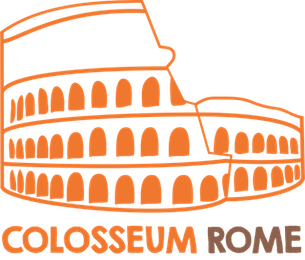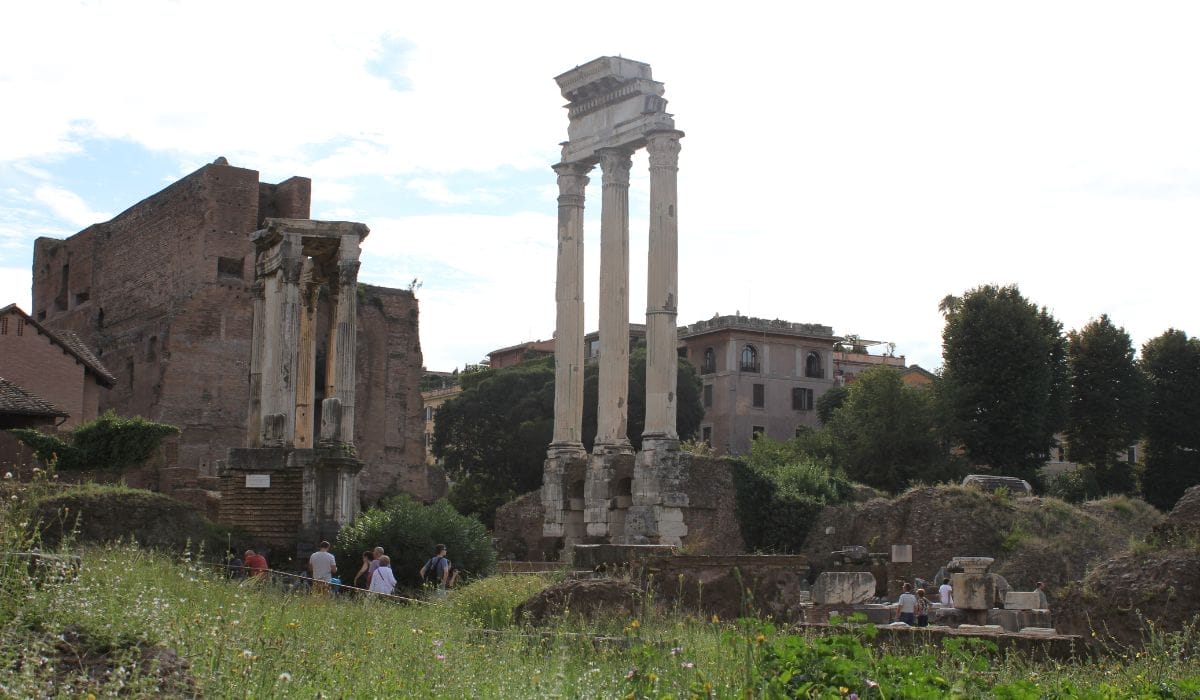
Temple of Castor and Pollux in Roman Forum (History Facts & Tickets)
The Temple of Castor and Pollux is a striking columned monument in the Roman forum, dedicated to the half-brother twins Castor and Pollux.
Let's uncover the history of this place together in this handy guide.
Contents
- 1 The Short History Behind The Temple Of Castor And Pollux
- 2 Who Were Castor And Pollux?
- 3 Symbol, Meaning & Why The Temple Of Castor And Pollux Is So Important
- 4 About The Temple Of Castor And Pollux Reconstruction
- 5 What Is Left Of The Temple Of Castor And Pollux Today
- 6 Interesting Facts About The Temple Of Castor And Pollux You Won’t Hear On Your Guided Tour
- 7 Temple Of Castor And Pollux Dimensions
- 8 2 of the Top Best Selling Guided Tours of the Roman Forum including the Temple of Castor and Pollux
- 9 Things You Don’t Want to Miss While You’re at the Roman Forum
- 10 How to Get Skip-the-line Tickets To The Temple of Castor and Pollux
- 11 Opening Hours & Best Time to Visit
- 12 Temple Of Castor And Pollux Location & How To Get There
- 13 3 Nice Places to Stay Nearby
- 14 Frequently Asked Questions
- 15 Conclusion
The Short History Behind The Temple Of Castor And Pollux
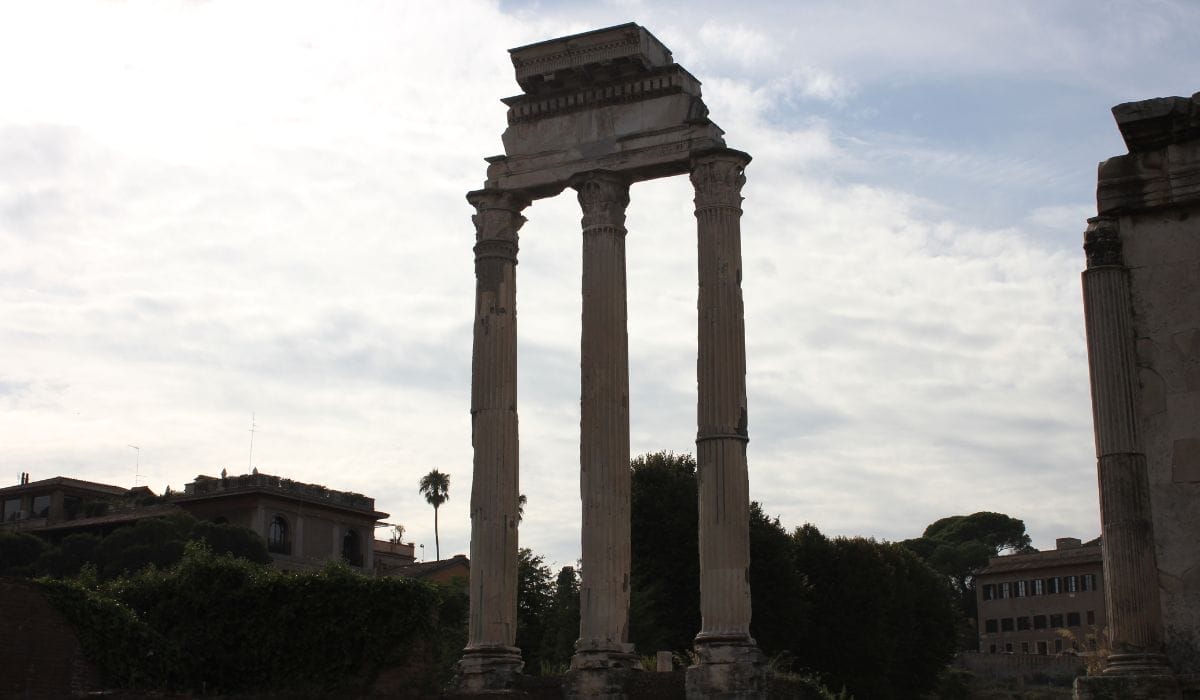
Legend has it that after the battle between the Roman Republic and the last Roman King Superbus, Castor and Pollux, who had fought on the side of the Republic, rocked up to the Roman Forum to let their horses drink.
They had been promised a sort of Castor and Pollux temple in their honor if they succeeded in battle by the current Roman dictator, and thus the temple of Castor and Pollux was born on the spot that they appeared in 495 BC!
Who Were Castor And Pollux?
Castor and Pollux appear in both Greek and Roman mythology as half brothers who are also twins.
How did that happen you may ask? Well, they had 2 different fathers, with Castor being of mortal heritage, and Pollux being divine, from Zeus. In Latin, they are called the Gemini, or Dioskouroi in Greek.
Symbol, Meaning & Why The Temple Of Castor And Pollux Is So Important
The twins became of huge importance to the Romans from around the 5th century BCE.
They were revered as a helping hand in battle and often depicted with horses and cavalry. The Corinthian Temple of Castor and Pollux was, therefore, a symbol of the might of the Roman Army and their strength in war.
It became known locally as Il Tempio dei Dioscuri, although there are other similar temples devoted to the twins in other parts of Europe.
About The Temple Of Castor And Pollux Reconstruction
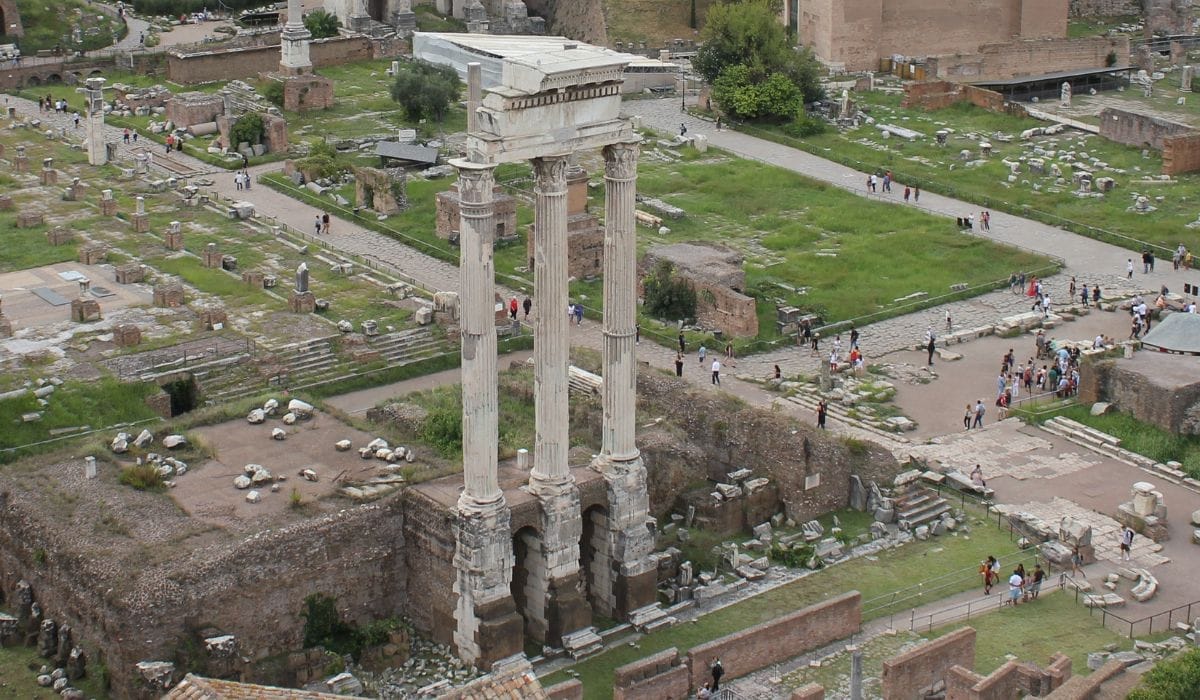
The temple has been reconstructed at least 3 times since it was built. The first reconstruction was in 117 BC, and it was again rebuilt by a Roman magistrate in 73 BC.
Then, in 6 BC Tiberius had to rebuild it again, after a fire destroyed a large section of it a few years prior. The columns that can still be seen today are from the part that Tiberius built.
What Is Left Of The Temple Of Castor And Pollux Today
Today, visitors to the Roman Forum can see the podium and three remaining columns. There is also a remaining piece of the entablature, which is the bridge between the columns.
Interesting Facts About The Temple Of Castor And Pollux You Won’t Hear On Your Guided Tour
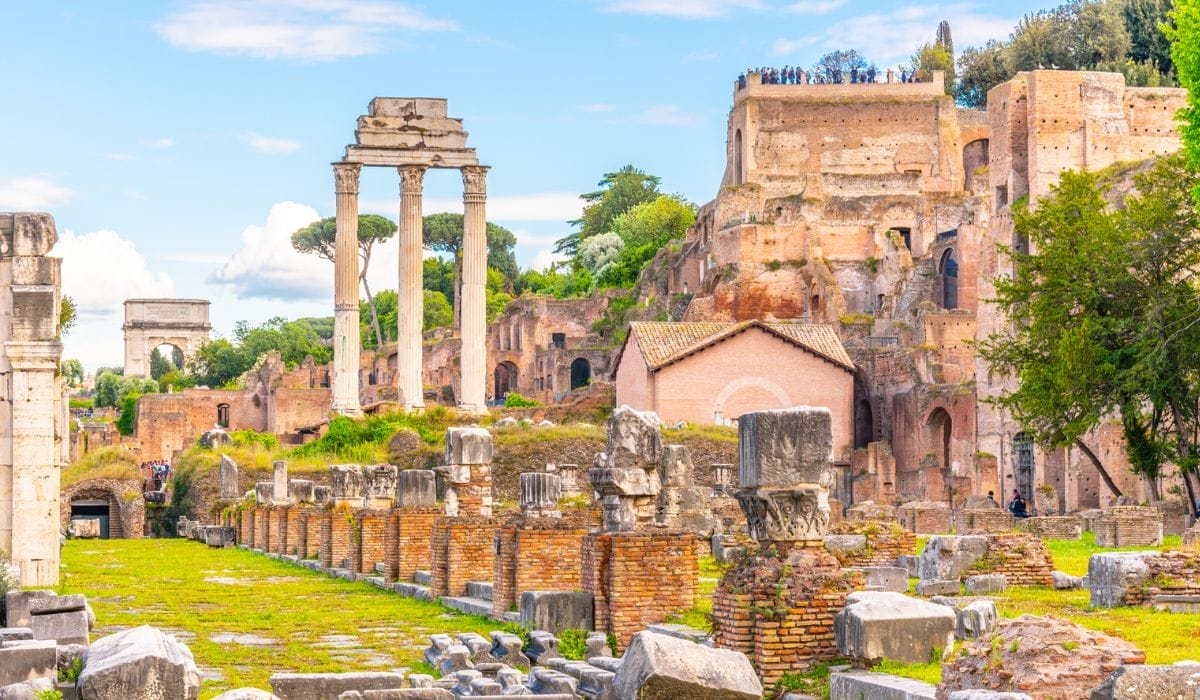
Here are some lesser-known Temple of Castor and Pollux facts you may not know:
- Twins with 2 different fathers such as Castor and Pollux do exist! It is possible for a woman to conceive twins from 2 different men!
- The brothers were actually siblings of Helen of Troy so the Temple has some pretty famous roots.
- The stars Castor and Pollux are named after the twins and give the Gemini constellation its famous name!
Temple Of Castor And Pollux Dimensions
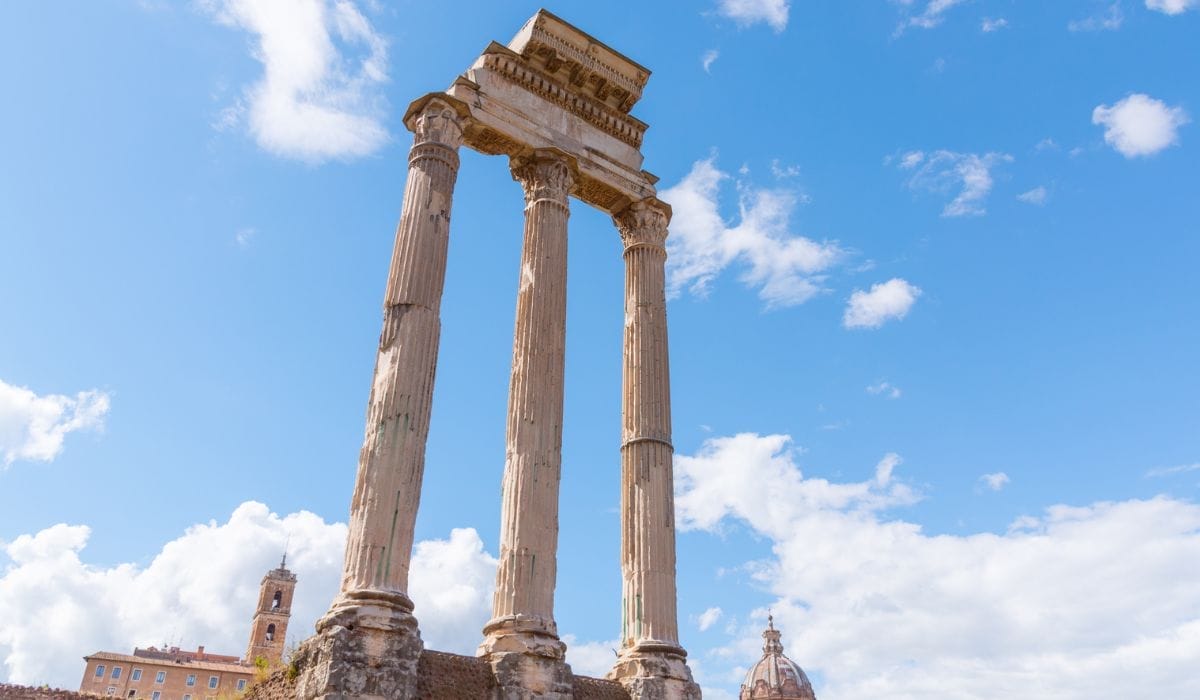
There were originally 34 columns of which only 4 remain today. The temple covered over 540,000m2 and stood at over 19m high.
That's a pretty impressive structure. After the first reconstruction, it was also extended!
2 of the Top Best Selling Guided Tours of the Roman Forum including the Temple of Castor and Pollux
Here are the best selling tours that people are booking for the fabulous Roman Forum to see attractions like the Temple of Castor and Pollux up close and personal:
- Rome: Colosseum, Roman Forum, Palatine Hill Entry Tickets – This all encompassing tour takes in the main gems that Rome has to offer, starting with the Colosseum. Once you are done there, head over to the Roman Forum to see the sights. Tickets start from just $36 and include fast track entry as well !
- Rome: Colosseum Arena, Roman Forum, & Palatine Hill Tour – For just over €20 this three hour tour of the Colosseum, Roman Forum and the Palatine Hill comes with multi language audio guide and fast track access to help you bump the queue.
Things You Don’t Want to Miss While You’re at the Roman Forum
The Roman Forum is JAM PACKED with attractions. So many in fact that it is impossible to name them all.
Tip – But if you only have time to see a few then make sure you at least check out the Temple of Saturn and the House of the Vestal Virgins.
How to Get Skip-the-line Tickets To The Temple of Castor and Pollux
Skip the line tickets are a MUST when visiting Rome – and even more so in the summer.
Check out some of the best deals here:
- Rome: Colosseum Hosted Entry Ticket with Arena Access – For €36 per person you not only get skip-the-line entry to the Colosseum – you also get access to the floor of the arena which is a restricted area.
- Rome: Skip-the-Line Colosseum, Forum and Palatine Hill Tour – Here’s another great example of a skip-the-line ticket for the Roman Forum. For just under €40 you can enter the main attractions without the big queue and all with an experienced English speaking tour guide.
Opening Hours & Best Time to Visit
Days | Hours |
Every Day | 9 am - 7:15 pm |
Note | In autumn and winter they close earlier |
The Roman Forum is open daily from 9 am every morning. Through the spring and summer, it is closed at 7.30 pm.
In autumn they close earlier – at 7 pm in September and 6.30 pm in October. In winter you should aim to be finished with your visit by 4.30 pm.
After visiting the Temple of Castor and Pollux, if you have some extra time, you might want to explore the nearby Theatre of Marcellus—it's a fascinating historical site that's free to visit.
Temple Of Castor And Pollux Location & How To Get There
The Roman Forum is located on the Via Sacra. You can get there via the Metro on Line B. Alight at the Colosseo Station and then make the way to the Temple and Castor Pollux Roman Forum entrance.
3 Nice Places to Stay Nearby
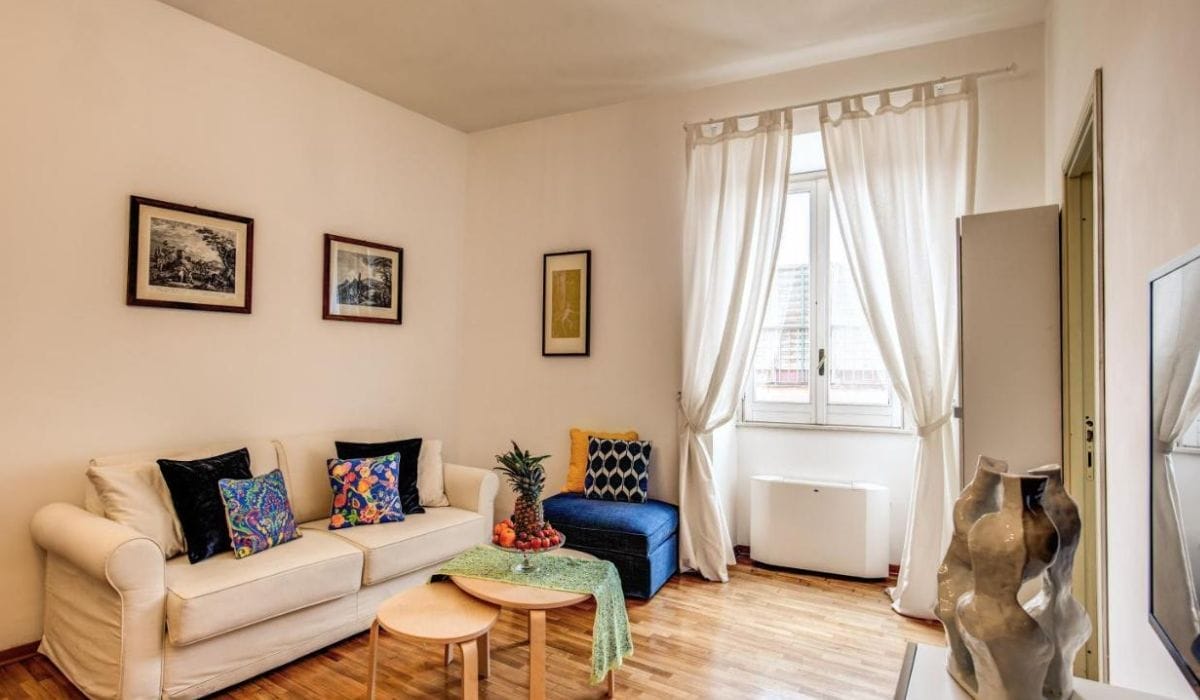
Want to wake up right bang smack in the center of the action?
Then check out these fun hotels near the Roman Forum.
Beautiful Colosseum Apartment
Gorgeous one-bed apartment that is located just 300m behind the Roman Forum and about a 15-minute walk from the Colosseum. A beautiful one bed starts from just €160 per night.
Colosseo Miracle Suite
This spacious 3-bed apartment is located right near the Colosseum and offers tons of space for a family visiting Rome. Rooms start from €300 per night.
Hotel Romano
This cute little hotel near the Roman Forum offers boutique rooms decorated each in their own style, some with great city views. Double start here from €150 per night.
Frequently Asked Questions

Who killed Castor and Pollux?
Castor was killed by Idas, but Pollux is the divine son of Zeus.
Who was the Temple of Castor and Pollux named after?
The Temple is named after the half twin brothers Castor and Pollux.
How tall is the Temple of Castor and Pollux?
The temple stood at 19m high.
When was the Temple of Castor and Pollux built and rebuilt?
The Temple was actually built and rebuilt at least 3 times, most recently by Tiberias in 6BC.
What was the Temple of Castor and Pollux used for?
It was not only a memorial but also a place for the Roman Senate to meet.
Which forum is the Temple of Castor and Pollux in?
The Temple is located in the Roman Forum.
Conclusion
Now you know where to stay and how to visit the Temple of Castor and Pollux in the Roman Forum, it's time to plan the rest of your trip.
Make sure to check out our city pass guides to Rome to get a feel for city passes and how useful they would be for your trip.
Fanny, an ardent admirer of ancient history and architecture, has been fascinated by the Colosseum since her first visit to Rome in 2012. As a key contributor to the Visit Colosseum Rome blog, she brings her passion for the Roman Empire’s monumental legacy to every article and guide.
